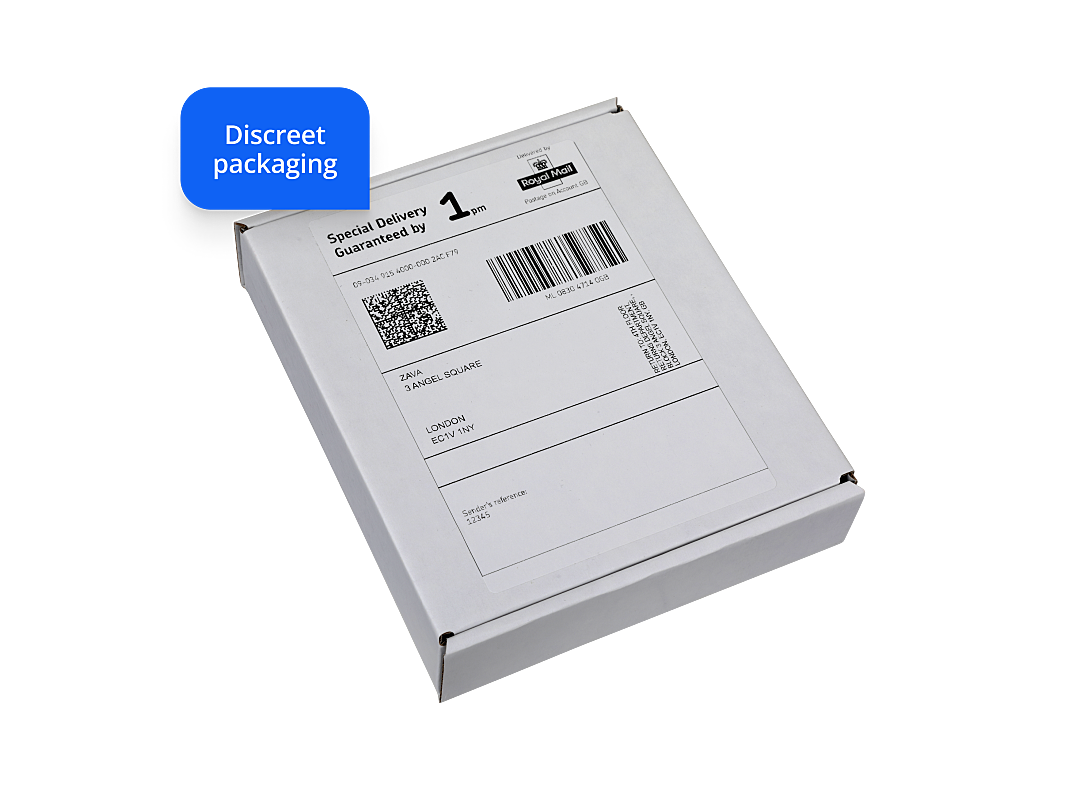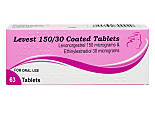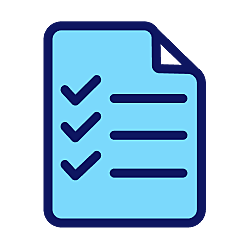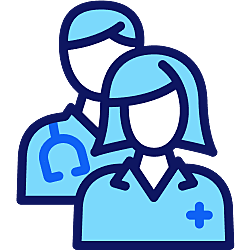Levest Pill
Levest is a combined pill containing a moderate amount of oestrogen. It has a medium chance of oestrogen-related benefits and side effects.




Prices from £19.00
In stock. Simply fill in a brief consultation questionnaire and one of our doctors will review your request today.
-
It contains the same active ingredients with the same doses as Microgynon, another combined pill. Levest can be over 99% effective when taken perfectly and is safe if approved by a doctor. Because it contains lactose and sucrose, it may be unsuitable for people who are lactose intolerant or fasting.



About Levest pill
-
-
Levest is a combined contraceptive pill that protects you from pregnancy. It contains 2 active ingredients, ethinylestradiol and levonorgestrel.
Levest is a combined oral contraceptive pill which contains the active ingredients levonorgestrel 150mcg and ethinylestradiol 30mcg. You take Levest daily and can be protected from pregnancy from the first pill, if you start it during the first 5 days of your period.
Levest can also help with painful or heavy periods as well as acne and can be suitable for women up to the age of 50.
Levest is a branded contraceptive pill manufactured by Morningside Healthcare.
What type of pill is Levest?
There are 2 types of contraceptive pills; the combined pill (often referred to as “the pill”) and the progestogen-only pill (POP or mini pill).
Levest is a combined birth control pill. It is made up of synthetic (man-made) versions of the female hormones oestrogen (sometimes spelled estrogen) and progesterone (also known as progestin or progestogen). Levest is also sometimes known as the ‘pink contraceptive pill’ because of its bright colour.
Levest is a monophasic pill, which means you take 1 tablet every day for 21 days, and then have a break of 7 days. Each tablet contains the same amount of hormones. It’s an effective contraceptive pill brand when taken correctly and is safe when prescribed by a doctor.
Levest is also a standard-oestrogen combined pill, because it contains 30mcg of oestrogen. This means it has a lower chance of causing oestrogen-related side effects than some pills, but higher than others. It may also have less oestrogen-related benefits, like improvements to premenstrual syndrome than higher-oestrogen pills.
Is Levest a combined pill?
“Yes, Levest is a combined contraceptive pill. Combined pills contain 2 active ingredients – levonorgestrel, which mimics the hormone progesterone and ethinylestradiol, which is similar to oestrogen. This is compared to mini pills which only contain progesterone.” – Dr Babak Ashrafi, Clinical Lead for Service Expansion.
-
-
Levest prevents pregnancy by mimicking the natural hormones you produce.
The levels of your natural hormones will change when you’re pregnant, causing changes that prevent additional pregnancies. By taking Levest daily, your body is given a steady dose of both oestrogen and progesterone. This puts a pause on your menstrual cycle for as long as you are taking Levest.
The active ingredients in Levest work to prevent pregnancy by:
- preventing ovulation (prevents eggs being released from your ovaries)
- thickening cervical mucus so sperm cannot reach an egg
- thinning the lining of the womb so an egg cannot grow
These effects are reversible. If you come off your pill, your chance of getting pregnant goes back to how it was before you started.
Remember that Levest does not protect against sexually transmitted infections (STIs). Only barrier contraceptives like condoms can protect you against STIs. Contact a doctor or visit a sexual health clinic if you think you may have an STI. You can also request STI test kits from ZAVA.
How long does Levest take to work?
If you start taking Levest birth control on the first day of your period, or within the first 5 days of your period, you will be protected immediately. If you start after the 5th day of your cycle, you should use additional contraception (such as condoms or the cap) for 7 days.
-
-
If you take Levest tablets as directed, the pill should be over 99% effective in preventing pregnancy. However, in real life it’s up to 9% (9 women out of every 100) who take the combined pill and become pregnant every year. This is because not everyone takes the pill perfectly and missing doses can reduce your protection.
The effectiveness of Levest can be reduced if you:
- miss a pill
- take the pill at a different time than usual
- throw up after taking it
- have severe diarrhoea after taking it
- take certain medications including antiepileptic drugs, some medicines for HIV, griseofulvin, modafinil, rifabutin or rifampicin
- take the herbal remedy St John’s wort
If you throw up or have diarrhoea after taking the pill, you should use an additional method of contraception while you are unwell and for 7 days after you feel better. You should contact your doctor if you throw up or have diarrhoea less than 4 hours after taking a pill to check if emergency contraception is needed.
If you use condoms while taking Levest, your chances of pregnancy will be even lower.
Is Levest safe?
As long as a doctor has approved Levest treatment for you, then it should be safe to take. When considering you for Levest treatment, your doctor will check your medical history and other medications you’re taking to make sure it’s safe for you.
Like all medications, Levest does come with a risk of side effects, but these are normally mild and go away by themselves shortly after you start treatment. See the side effects section of this page for more information.
-
-
Contraceptive combined pills are available free of charge for everyone on the NHS, from your GP, contraception clinics, sexual health clinics, pharmacies and some young people’s services. However, you may need to make an appointment and speak to a doctor or healthcare worker in-person before they are prescribed.
If you would prefer to request Levest online without visiting a doctor, it is available from reputable online doctors such as ZAVA.
Where can I get Levest online?
You can request Levest pills online from online doctor services like ZAVA.
It’s very simple to place a request:
- fill out an online form and answer a few easy questions about your health
- place a request for your treatment by logging in or signing up and making payment
- one of our doctors will review your answers and check if treatment is right for you
- if your request is approved, your medication will arrive via Royal Mail delivery or you can pick it up from a local Post Office
Can you buy Levest without a prescription?
No, Levest is only available on prescription. There are brands available to buy over-the-counter (OTC), however. Hana and Lovima are 2 desogestrel mini pills that you can buy over-the-counter in pharmacies.
You can request Levest online without a pre-existing prescription using online doctor services like ZAVA.
-
-
You should take your Levest combined pill at the same time each day. Take 1 every day for 21 days, with or without food. Once you’ve taken all 21 pills, you would normally take a 7-day break. So if you take the last pill of one pack on a Friday, start the next on the Saturday of the following week. You do not have to use additional contraception during this pill-free period.
You should start to bleed within a few days of taking your last pill in the cycle, and you may still be bleeding when it’s time to take your next pill.
Each Levest pill is marked on the strip with the day of the week on which you should take it. This will help you keep to the schedule. You can also use pill organisers and pill reminder apps.
When to start taking Levest
If you have regular periods and start taking Levest during the first 5 days of your period, you will have contraceptive protection from the first pill. If you start at any other time in your cycle, use extra protection such as condoms for the first 7 days.
You may experience some mild side effects when you first start taking Levest, but these are usually mild and can go away after a few weeks.
Can you take Levest continuously (without a break)?
Yes, you can take Levest with no break, which is known as ‘continuous use’. Taking the pill in this way will delay your withdrawal bleed. Some women choose to delay their bleed for personal or therapeutic reasons. Another option is to complete 3 full cycles of pills, followed by a 7-day break. This is known as ‘tricycling’.
Taking the pill continuously is safe to do.
Levest missed pill: What if I miss a pill?
If you have missed a Levest pill, check when you were supposed to take it. If it has been:
- less than 24 hours, take the missed pill as soon as you remember. You should still have contraceptive protection.
- more than 24 hours, take the most recent missed pill immediately. This might mean taking 2 pills on the same day. If you do this you can carry on taking your pill as normal and no additional contraception is needed.
If you start your next strip more than 48 hours late following a 7 day break, or you miss 2 to 7 pills in the first week of your pack, then you might need emergency contraception, like the morning after pill.
The prescriber of your emergency contraception should let you know whether to continue your pill and how long to use condoms for, as this depends on which emergency contraception you use. It’s a good idea to take a pregnancy test 3 weeks after any episodes of unprotected sex.
➤ See our page on what to do if you miss the pill for more information.
Do I need to take emergency contraception?
If you miss:
- 2 to 7 pills in week 2 or 3 of your strip of Levest, then you don’t need emergency contraception, providing you’ve taken the pills as instructed in the previous 7 days. You should continue your pill as normal, use condoms for the next 7 days and move straight to your next strip without a break if you missed pills in week 3.
- more than 7 pills at any point then emergency contraception would be recommended if you want to avoid pregnancy. Also, you should discuss with the prescriber of your emergency contraception about how best to restart your pill. You’d need to take a pregnancy test 3 weeks after any episodes of unprotected sex.
This advice might be different to the instructions in your pill pack as newer studies mean that guidelines on missed pills have been updated recently. If you have any questions about what to do after a missed pill it’s always best to contact your doctor or pharmacist for advice. Or you can contact us through your patient account.
What happens when you stop taking the Levest pill
You can get pregnant as soon as you come off the pill, so if you don’t want to have a baby, you need to use another form of contraception.
You may experience a withdrawal bleed after coming off the pill. It usually takes around 4 weeks for your natural period to restart after stopping Levest and your cycle may be irregular for up to 3 months.
Any symptoms previously associated with your period that were being improved by Levest may return. These might include:
- headaches
- breast tenderness
- period pain
- acne
- irregular periods
- mood changes
Other side effects of stopping Levest can include:
- weight change
- lower or higher sex drive
-
-
The contraceptive pill side effects Levest can cause are not usually long-term and some will resolve within a few hours after taking a pill. Some combined pill side effects might take up to a couple of months to disappear. This is because your body is still getting used to the changing levels of hormones.
If your Levest pill side effects are concerning you, speak to your doctor or pharmacist.
Common Levest side effects include:
- feeling sick
- headaches
- low mood or mood swings
- tender or sore breasts
Uncommon Levest side effects include:
- being sick or having diarrhoea
- migraine
- fluid retention
- loss of interest in sex
- increase in breast size
- skin rash
If you develop migraines while using Levest, it’s important to contact your doctor. They can give you advice on possible alternatives. It’s also important to discuss any new breast symptoms that occur while taking Levest with a doctor, such as breast lumps.
There is a possible link between the Levest contraceptive pill and weight gain which is mild or temporary. Combined contraceptive pills can cause temporary weight gain, which will usually go away once you stop taking them.
When taking a combined contraceptive pill like Levest there is a slightly increased risk of developing a blood clot. If you are not taking any hormonal birth control, your risk of blood clots is around 2 in 10,000 women. If you take Levest, your risk increases slightly to around 5 to 7 in 10,000. This shows that the risk of blood clots is very small, but you should still be aware of the symptoms.
If you have any of these symptoms after taking Levest, call 999 immediately:
- swelling or redness in your leg
- shortness of breath
- chest pain
- fainting
- coughing up blood
If you notice any other severe side effects, please contact a doctor immediately.
For further information on side effects, you can read the patient information leaflet.
-
-
Levest contains the active ingredients levonorgestrel 150mcg and ethinylestradiol 30mcg. Each coated tablet contains 52.353 mg of lactose monohydrate and 14.187 mg of sucrose. Other Levest ingredients include:
- maize starch
- povidone k-25
- tacl
- calcium carbonate
- povidone k-90
- glycerin
- macrogol 6000
- titanium dioxide
- magnesium stearate
- carnauba wax
Is Levest a strong pill?
“Levest is considered to be a standard-strength pill, alongside other combined pills such as Microgynon 30, Ovranette and Rigevidon. However, a higher dose of hormones does not mean that a pill provides better protection. It does increase the risk of oestrogen-related side effects and the chance of oestrogen-related benefits too.” – Dr Babak Ashrafi, Clinical Lead for Service Expansion.
-
-
Levest is a safe and effective pill for many women. A doctor can assess you to see if you are able to start Levest treatment. Levest is meant for people who are at risk of unwanted pregnancies. If a doctor has approved treatment for you, then you can safely take Levest.
-
-
Some people should not take the Levest pill. Your GP or one of our online doctors can advise whether you can take combined pills like Levest. Levest is not meant for people who have contraindications, which are personal or health circumstances that make Levest unsafe. Levest may also not be right for you if you’re taking other medications that may interact with Levest.
Levest contraindications
You should not take Levest if you:
- are pregnant or think you could be pregnant
- are breastfeeding a baby less than 6 weeks old
- are allergic to ethinylestradiol, levonorgestrel or any other ingredients in Levest
- have had a blood clot in your legs, lungs or anywhere else in your body
- have a condition that increases your risk of blood clots
- have had a stroke or heart attack in the past or have angina (chest pain)
- have migraine with aura
- have had breast cancer
If you have any underlying health conditions, speak to your doctor to find out if Levest is suitable for you. You can also message us through your patient account. This might include uncontrolled diabetes, severe high blood pressure or a high level of cholesterol (fat) in your blood.
Speak to your doctor if you:
- are overweight
- are over 35
- smoke
- will be off your feet for a long duration, such as after having an operation
- have a condition affecting your bowel or stomach
- have systemic lupus erythematosus (SLE)
- have a history of high blood pressure
- have had an organ transplant
- have a family history of blood clots
- have conditions affecting your heart
- have gallbladder disease
- have liver disease
- have recently given birth and want to take contraception
Your doctor will be able to check if Levest is suitable for you to take. If not, they may recommend a different type of contraceptive pill, such as the mini pill.
Levest interactions
Levest may interact with some medications, including:
- epilepsy treatment, such as carbamazepine or phenytoin
- treatment for HIV, such as ritonavir
- griseofulvin, an antifungal medication
- some antibiotics, like rifampicin
- herbal remedies, such as St John’s wort for low mood
- ellaOne, the morning after pill
Levest may make these, and other medications, less effective or vice versa. Levest can also be affected by drugs that cause diarrhoea or vomiting, such as laxatives. Speak to your doctor or pharmacist if you are taking any medications or any over-the-counter or herbal products.
-
-
You can find a variety of different contraceptive pills at ZAVA. If you experience side effects when taking Levest, you can try another type of combined pill. It’s best to contact a doctor for advice on which pill to try next.
➤ See our page on contraceptive pill brands for more information.
There are also alternative contraceptive methods besides other combined pills, including:
- the progesterone-only pill or mini pill, such as Cerelle or Noriday
- non-hormonal barrier methods like condoms or a diaphragm
- long-acting reversible contraceptives (LARCs) such as the contraceptive implant or contraceptive coil
You can find out more about these methods in our guide to types of contraception.
If you need emergency contraception, you may need the morning after pill. The morning after pill is taken after you have had unprotected sex, or if your usual contraceptive methods have failed.
Is Levest the same as Microgynon 30?
Microgyon is another brand with the same active ingredients in the same doses as Levest. However, the other ingredients included in both pills are slightly different. For example, Levest contains 52.353 mg of lactose monohydrate and 14.187 mg of sucrose while Microgynon 30 includes 32.820 mg of lactose monohydrate and 19.371 mg of sucrose.
Levest and Microgynon are taken in the same way, at the same dosage. Both are equally effective, have the same non-contraceptive benefits and the same risk of side effects.
-
-
-
Levest is a safe, effective form of birth control, as long as it is approved by a doctor and used as advised.
Levest can be a good choice if:
- you want the extra benefits that oestrogen provides, like improvements to periods or acne
- don’t have any contraindications that make oestrogen treatment unsafe, like a history of migraines or you’re over 35 and smoke
If this is not the case, you may wish to consider a different type of contraceptive method.
-
Frequently asked questions
Does Levest stop your period?
Yes, Levest does stop your period, but if you take a 7-day break from the pills, you may experience a breakthrough bleed. You can choose to delay these bleeds by taking the pills continuously or in 3-month cycles.
Does Levest make you gain weight?
Yes, Levest can cause temporary weight gain as a side effect. Not everyone experiences this and it usually goes back to normal once you stop taking Levest.
Can Levest cause acne?
Levest contains levonorgestrel that can cause oily skin, and therefore spots. Acne is a listed side effect of Levest. However, many people report that their existing acne improves, and many doctors prescribe combined contraceptive pills to treat acne.
See our page on the contraceptive pill and acne for more information.
Can Levest cause anxiety?
Anxiety is a listed side effect of Levest. Not everyone will get anxiety as a side effect but it is possible to develop anxiety or have existing anxiety or mood disorders become worse as a result of taking Levest.
What happens if a man takes Levest?
If a cisgender man or person assigned male at birth takes 1 or 2 birth control pills there will be very little effect. However, if a man took the pill longer-term, there may be some feminising effects, including slight breast development and a reduced sperm count. There may be health risks, so you should only take hormone tablets if you have had treatment approved by a doctor or pharmacist.
Can the Levest pill cause tiredness?
It’s not common, but tiredness and fatigue is listed as a side effect of Levest contraceptive pills. There are some studies that show that hormones, particularly progesterone, can cause sleepiness.
Can the Levest pill cause hair loss?
Yes, progesterone can potentially cause hair loss, but this is usually temporary.
Does Levest cause depression?
Depression is a listed, but rare side effect of Levest. Studies have shown links between hormonal contraception and depression.

Dr Babak Ashrafi Clinical Lead for Service Expansion
Accreditations: BSc, MBBS, MRCGP (2008)
Babak studied medicine at King’s College London and graduated in 2003, having also gained a bachelor’s degree in Physiology during his time there. He completed his general practice (GP) training in East London, where he worked for a number of years as a partner at a large inner-city GP practice. He completed the Royal College of GPs membership exam in 2007.
Meet our doctorsLast reviewed: 17 Oct 2023
-
Levest 150/30 Coated Tablets (2022) Morningside Healthcare [accessed 17 October 2023]
-
Where can I get contraception? (2021) NHS [accessed 17 October 2023]
-
Combined pill (2020) NHS [accessed 17 October 2023]
-
When will my periods come back after I stop taking the pill? (2022) NHS [accessed 17 October 2023]
-
Contraception Mythbusters: It is not safe to take COC continuously without a monthly break (2017) FSRH [accessed 17 October 2023]
Contraceptive pills are a reliable way of reducing your risk of getting pregnant from sex. ZAVA offers most common brands of pill, so you can order your preferred brand by visiting our contraceptive pill service page.
In stock. Prices from £19.00








